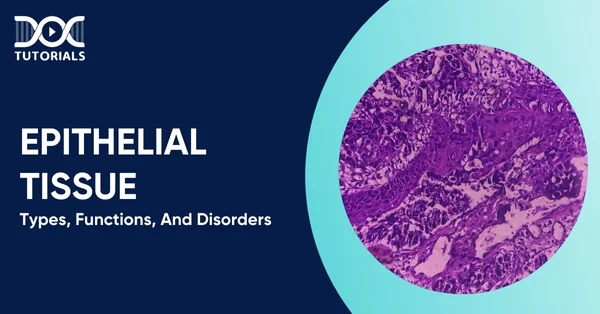Epithelial Tissue: Types, Functions, And Disorders

There are four types of tissues found in our body. Epithelial tissue, or the epithelium, is one of them. It forms a protective covering over both internal organs and external body surfaces. The epithelium is present on the surface of our skin and the linings of internal organs and glandular structures.
Epithelial tissue is a foundational topic in human anatomy, and all aspiring doctors preparing for the NEET PG exam should have an in-depth idea about it. This article will help you build a strong foundation on epithelial tissue types, their functions, and other details.
Keep reading!
What is Epithelial Tissue?
Epithelial tissue is made of epithelial cells. These cells are tightly bound and form continuous sheets, creating the surfaces of the inner and outer organs of our body. Epithelial cells are present throughout the body, and their location determines their functions.
Anything that enters the organs has to penetrate the protective boundary of the epithelium. The functions of this tissue, besides protection, include secretion, absorption, excretion, filtration, diffusion, and sensory reception.
The distinct features of the structure of epithelial tissue are:
- Microvilli: Non-motile, finger-like structures on the cell surface. They increase the rate of absorption.
- Cilia: Motile, hair-like structures on the surface that help move substances across the cells’ surface.
- Stereocilia: Long, non-motile structures that look like cilia but are specialised microvilli.
What are the Different Types of Epithelial Tissues?
Based on shape and structure, epithelial cells are classified into:
- Squamous Epithelium: Cells in the squamous epithelium are flat and tightly bound to produce long, sheet-like structures.
- Cuboidal Epithelium: Cells in the cuboidal epithelium resemble a cube. They have the same height, width, and length.
- Columnar Epithelium: The cells in the columnar epithelium look like cuboids. Their length is longer than their width.
Based on the arrangement of cells, the epithelial tissue types are:
- Simple Epithelium: Simple epithelial tissue is made of only one layer of cells and forms a sheet-like structure.
- Stratified Epithelium: Stratified epithelial tissue consists of more than one layer of cells stacked on top of each other.
- Pseudostratified Epithelium: Pseudostratified epithelial tissue appears to have several different types of cells stacked on top of each other. However, it is a single layer composed of differently shaped cells.
By combining the types of shapes and layers, epithelial tissues are further classified into:
| Type of Epithelium | Location | Function |
| Simple Squamous Epithelium | Blood vessels and body cavities | Regulates the passage of substances (diffusion and filtration) into the underlying tissue |
| Simple Cuboidal Epithelium | Glands and kidney linings | Secretion and absorption |
| Simple Columnar Epithelium | Stomach and intestines(may have microvilli or cilia) | Specialised for absorption |
| Stratified Squamous Epithelium | Outer layer of skin, oral cavity, oesophagus and vagina | Protect against microorganisms, mechanical stress, and water loss |
| Stratified Cuboidal Epithelium(not very common) | Sweat glands and salivary glands (have a lot of cilia) | Protection and mucus movement |
| Stratified Columnar Epithelium | Lining of the eyelids (conjunctiva) | Protection and mucus secretion |
| Pseudostratified Columnar Epithelium | Upper respiratory tract | Secretion and mucus movement |
The different types of epithelial tissue, based on their specialised functions, are as follows:
- Transitional Epithelium: Transitional epithelial tissues are also known as urothelium. These tissues are composed of multiple layers of cells that flatten out when stretched.
- Glandular Epithelium: This type of epithelial tissue is known for its producing (secreting) function. The lining of glands is made of this type of tissue.
- Olfactory Epithelium: As the name suggests, the olfactory epithelial cells are located in the nasal cavity. The cilia on the cells trap the odour, and the receptors then send this information to the olfactory bulb, where the brain processes and interprets the smell.
What are the Functions of Epithelial Tissues?
Epithelium forms the primary part of our anatomy and performs essential functions. These functions vary based on their location. The primary functions of this tissue include:
- Protection: The epithelial tissues line the surface of the skin and internal organs, shielding them from environmental harm, physical injury, harmful chemicals, and pathogens.
- Secretion: Epithelial tissue present in the glands releases hormones, proteins, and fluids as required by the body.
- Absorption: The lining of internal organs (liver, lungs, and intestines) consists of epithelial tissue. Additionally, the intestinal epithelial tissues specialise in absorbing nutrients from food.
- Excretion: The sweat gland, whose lining is made of epithelial tissue, helps excrete sweat as a waste product.
- Filtration: Epithelial cells with cilia are present in the respiratory tract. They filter out the dirt and clean the inhaled air.
- Diffusion: Particles moving from regions of higher concentration towards lower concentration is called diffusion. The epithelial tissue formed by simple squamous cells supports selective diffusion, which allows the absorption and filtration of materials that pass through the membrane.
- Sensory Reception: Some epithelial tissues have embedded nerve endings. For example, sensory receptors known as taste buds are found on the tongue, which is covered by a layer of stratified squamous epithelium.
What are the Common Disorders of Epithelial Tissues?
Despite the epithelium’s ability to assess threats and respond accordingly (homeostasis), it is prone to certain diseases and disorders.
- Cancer
One of the major concerns about the epithelium is its potential to develop cancer. Tumours are usually found in the digestive tract or on the skin. However, if they spread to a certain membrane, they become malignant and are termed carcinoma.
The majority of breast cancers, prostate cancers, pancreatic cancers, colorectal cancers, and non-small cell lung cancers account for adenocarcinomas.
- GERD
GERD (Gastro-Esophageal Reflux Disorder) is another disease that significantly affects the epithelial tissues of the oesophageal lining. The following is a detailed overview:
- The oesophagus has a mucus membrane that protects underlying tissues from acid-related injury.
- This membrane is compromised during GERD. Therefore, the acid penetrates deeper, causing symptoms such as pain, burning, and difficulty swallowing.
- In continuation of the effect on the oesophagus, the body initiates a procedure called metaplasia (metaplastic transformation). Here, the stratified squamous epithelial cells in the oesophageal lining get replaced by columnar epithelial cells.
- This condition is widely known as Barrett’s Esophagus. Since the columnar cells (better at absorbing acid) are not native to the oesophagus, they require a certain amount of adaptation.
- This change in the body is only a short-term protection. If Barrett’s Esophagus persists, there is a high chance that the body will develop oesophageal adenocarcinoma.
Other disorders that affect the epithelium include:
- Celiac disease
- Asthma
- Human Papilloma Virus (HPV)
- Vertigo
FAQs About Epithelial Tissue
- Does epithelial tissue regenerate?
Yes, the epithelial tissue can regrow and repair itself by rapid cell division. This process is called epithelization.
- Is epithelial tissue the same throughout the body?
No, there are different types of epithelial tissue. For example:
- The skin has stratified squamous epithelium.
- The intestinal lining has simple columnar epithelium.
- The bladder has transitional epithelium.
- Can epithelial tissue become cancerous?
Epithelial tissues have a high probability of being cancerous. Breast cancer, prostate cancer, and non-small cell lung cancer all form in the epithelial tissue. Frequent exposure to toxins such as chemicals or UV light increases the risk.
- What do cilia do in epithelial tissue?
Cilia are structural extensions on epithelial cells. They resemble hair and aid in absorption and movement. Epithelial tissue in the uterus has cilia, which help in the movement of the egg toward the uterus.
- What are epithelial cells?
Epithelial cells comprise the structure of epithelial tissue. These cells are tightly packed together and perform functions like secretion, sensation, protection, and absorption.
Conclusion
Epithelial tissue plays a crucial role in human anatomy. It forms the lining of all internal organs as well as the outer layer of the skin. The function and structure of epithelial tissue vary based on its location. Continuous irritation of the epithelial lining due to disorders like GERD can cause serious conditions like cancer or Barrett’s Esophagus.
As an aspiring medical professional, knowledge of epithelial tissue and its features is fundamental. At DocTutorials, we provide comprehensive NEET PG study materials on various topics related to medicine, anatomy, obstetrics, dermatology and more.
What’s more, our curated video tutorials and mock tests will help scale up your NEET preparations.
Check out our courses today!
Latest Blogs
-

NEET SS Exam 2024: Analysis, Key Dates, Counselling
The NEET SS 2024 exam kicked off on March 29, 2025. Over two days and two slots, candidates across 13…
-

NEET PG Registration 2025: An Essential Guide For Exam Prep
The NEET PG registration, which is conducted online, is a crucial step in the exam process. Filling out the NEET…
-

NEET PG Syllabus 2026: A Must-Have Complete Guide for Exam Success
The NEET PG Syllabus acts as one of the foundation stones for aspiring postgraduate medical students like you who are…




